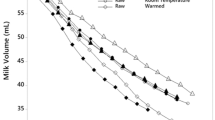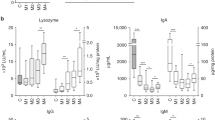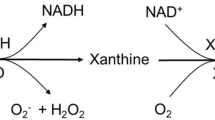Abstract
Background
The microbiological safety of donor milk (DM) is commonly ensured by Holder pasteurization (HoP, 62.5 °C for 30 min) in human milk banks despite its detrimental effects on bioactive factors. We compared the antimicrobial properties of DM after Holder pasteurization treatment or High Hydrostatic Pressure processing (HHP, 350 MPa at 38 °C), a non-thermal substitute for DM sterilization.
Methods
We assessed lactoferrin and lysozyme concentrations in raw, HHP- and HoP-treated pools of DM (n = 8). The impact of both treatments was evaluated on the growth of Escherichia coli and Group B Streptococcus in comparison with control media (n = 4). We also addressed the effect of storage of HHP treated DM over a 6-month period (n = 15).
Results
HHP milk demonstrated similar concentrations of lactoferrin compared with raw milk, while it was significantly decreased by HoP. Lysozyme concentrations remained stable regardless of the condition. Although a bacteriostatic effect was observed against Escherichia coli at early timepoints, a sharp bactericidal effect was observed against Group B Streptococcus. Unlike HoP, these results were significant for HHP compared to controls. Stored DM was well and safely preserved by HHP.
Conclusion
Our study demonstrates that this alternative sterilization method shows promise for use with DM in human milk banks.
Impact
-
Antimicrobial activity of donor milk after High Hydrostatic Pressure treatment has not been clearly evaluated.
-
Donor milk lactoferrin is better preserved by High Hydrostatic Pressure than conventional Holder pasteurization, while lysozyme concentration is not affected by either treatment.
-
As with Holder pasteurization, High Hydrostatic Pressure preserves donor milk bacteriostatic activity against E. coli in addition to bactericidal activity against Group B Streptococcus.
-
Donor milk treated by High Hydrostatic Pressure can be stored safely for 6 months.
This is a preview of subscription content, access via your institution
Access options
Subscribe to this journal
Receive 14 print issues and online access
$259.00 per year
only $18.50 per issue
Buy this article
- Purchase on Springer Link
- Instant access to full article PDF
Prices may be subject to local taxes which are calculated during checkout


Similar content being viewed by others
Data availability
The datasets generated during and/or analysed during the current study are available from the corresponding author on reasonable request.
References
Zhang, S. et al. Gold standard for nutrition: a review of human milk oligosaccharide and its effects on infant gut microbiota. Micro. Cell Fact. 20, 108 (2021).
Sánchez, C. et al. Breast milk: a source of functional compounds with potential application in nutrition and therapy. Nutrients 13, 1026 (2021).
Mayeur, S., Spahis, S., Pouliot, Y. & Levy, E. Lactoferrin, a pleiotropic protein in health and disease. Antioxid. Redox Signal. 24, 813–836 (2016).
Artym, J. & Zimecki, M. Antimicrobial and prebiotic activity of lactoferrin in the female reproductive tract: a comprehensive review. Biomedicines 9, 1940 (2021).
Telang, S. Lactoferrin: a critical player in neonatal host defense. Nutrients 10, E1228 (2018).
Lönnerdal, B. Bioactive proteins in human milk-potential benefits for preterm infants. Clin. Perinatol. 44, 179–191 (2017).
Ohradanova-Repic, A. et al. Time to kill and time to heal: the multifaceted role of lactoferrin and lactoferricin in host defense. Pharmaceutics 15, 1056 (2023).
Vogel, J. P. et al. The global epidemiology of preterm birth. Best. Pract. Res. Clin. Obstet. Gynaecol. 52, 3–12 (2018).
Van Gysel, M., Cossey, V., Fieuws, S. & Schuermans, A. Impact of pasteurization on the antibacterial properties of human milk. Eur. J. Pediatr. 171, 1231–1237 (2012).
Stoll, B. J. et al. Early-onset neonatal sepsis 2015 to 2017, the rise of escherichia coli, and the need for novel prevention strategies. JAMA Pediatr. 174, e200593 (2020).
Glaser, M. A., Hughes, L. M., Jnah, A. & Newberry, D. Neonatal sepsis: a review of pathophysiology and current management strategies. Adv. Neonatal Care 21, 49–60 (2021).
Jenke, A. C. et al. S100A12 and hBD2 correlate with the composition of the fecal microflora in ELBW infants and expansion of E. coli is associated with NEC. Biomed. Res. Int. 2013, 150372 (2013).
Chong, H.-Y. et al. Exploring the potential of human milk and formula milk on infants’ gut and health. Nutrients 14, 3554 (2022).
Landers, S. & Updegrove, K. Bacteriological screening of donor human milk before and after Holder pasteurization. Breastfeed. Med. 5, 117–121 (2010).
Zimmermann, P., Gwee, A. & Curtis, N. The controversial role of breast milk in GBS late-onset disease. J. Infect. 74, S34–S40 (2017).
Widger, J., O’Connell, N. H. & Stack, T. Breast milk causing neonatal sepsis and death. Clin. Microbiol. Infect. 16, 1796–1798 (2010).
Picaud, J.-C. & Buffin, R. Human milk-treatment and quality of banked human milk. Clin. Perinatol. 44, 95–119 (2017).
Pitino, M. A. et al. High hydrostatic pressure processing better preserves the nutrient and bioactive compound composition of human donor milk. J. Nutr. 149, 497–504 (2019).
Hite, B. The effect of pressure in the preservation of milk: a preliminary report. West Va. Agric. For. Exp. Station Bull. https://doi.org/10.33915/agnic.58 (1899).
Considine, K. M., Kelly, A. L., Fitzgerald, G. F., Hill, C. & Sleator, R. D. High-pressure processing–effects on microbial food safety and food quality. FEMS Microbiol. Lett. 281, 1–9 (2008).
Demazeau, G. et al. A new high hydrostatic pressure process to assure the microbial safety of human milk while preserving the biological activity of its main components. Front. Public Health 6, 306 (2018).
Wesolowska, A. et al. New achievements in high-pressure processing to preserve human milk bioactivity. Front. Pediatr. 6, 323 (2018).
Marousez, L. et al. Metabolic hormones in human breast milk are preserved by high hydrostatic pressure processing but reduced by Holder pasteurization. Food Chem. 377, 131957 (2022).
Barbarska, O. et al. Effect of nonthermal processing on human milk bactericidal activity against Escherichia coli. J. Pediatr. Gastroenterol. Nutr. 70, 864–867 (2020).
Viazis, S., Farkas, B. E. & Jaykus, L. A. Inactivation of bacterial pathogens in human milk by high-pressure processing. J. Food Prot. 71, 109–118 (2008).
Marousez, L. et al. High hydrostatic pressure processing of human milk preserves milk oligosaccharides and avoids formation of Maillard reaction products. Clin. Nutr. 41, 1–8 (2022).
Trend, S. et al. Antimicrobial protein and peptide concentrations and activity in human breast milk consumed by preterm infants at risk of late-onset neonatal sepsis. PLoS One 10, e0117038 (2015).
Fekraoui, F. et al. Cycling versus continuous high pressure treatments at moderate temperatures: effect on bacterial spores? Innovative Food Sci. Emerg. Technol. 74, 102828 (2021).
EFSA Panel on Biological Hazards (BIOHAZ Panel). et al. The efficacy and safety of high-pressure processing of food. EFSA J. 20, e07128 (2022).
Kontopodi, E. et al. Effects of high-pressure processing, UV-C irradiation and thermoultrasonication on donor human milk safety and quality. Front. Pediatr. 10, 828448 (2022).
Franch, A. et al. Banked human milk treatment and immunoactive factors content. Comparison with high pressure processing. Proc. Nutr. Soc. 69, https://doi.org/10.1017/S0029665110000777 (2010).
Billeaud, C. High hydrostatic pressure treatment ensures the microbiological safety of human milk including bacillus cereus and preservation of bioactive proteins including lipase and immuno-proteins: a narrative review. Foods 10, 1327 (2021).
Beverly, R. L., Woonnimani, P., Scottoline, B. P., Lueangsakulthai, J. & Dallas, D. C. Peptides from the intestinal tract of breast milk-fed infants have antimicrobial and bifidogenic activity. Int. J. Mol. Sci. 22, 2377 (2021).
Aceti, A. et al. Effect of alternative pasteurization techniques on human milk’s bioactive proteins. J. Pediatr. Gastroenterol. Nutr. https://doi.org/10.1097/MPG.0000000000002598 (2019).
Zhang, J. et al. Comparing the effects of hydrostatic high-pressure processing vs holder pasteurisation on the microbial, biochemical and digestion properties of donor human milk. Food Chem. 373, 131545 (2022).
Donovan, S. M. The role of lactoferrin in gastrointestinal and immune development and function: a preclinical perspective. J. Pediatr. 173, S16–S28 (2016).
Villavicencio, A., Rueda, M. S., Turin, C. G. & Ochoa, T. J. Factors affecting lactoferrin concentration in human milk: how much do we know? Biochem. Cell Biol. 95, 12–21 (2017).
Zhang, Y., Lu, C. & Zhang, J. Lactoferrin and its detection methods: a review. Nutrients 13, 2492 (2021).
Viazis, S., Farkas, B. E. & Allen, J. C. Effects of high-pressure processing on immunoglobulin a and lysozyme activity in human milk. J. Hum. Lact. 23, 253–261 (2007).
Wesolowska, A. et al. Innovative techniques of processing human milk to preserve key components. Nutrients 11, E1169 (2019).
Peila, C. et al. The effect of holder pasteurization on nutrients and biologically-active components in donor human milk: a review. Nutrients 8, E477 (2016).
Fields, D. A., Schneider, C. R. & Pavela, G. A narrative review of the associations between six bioactive components in breast milk and infant adiposity. Obesity 24, 1213–1221 (2016).
Silvestre, D., Ruiz, P., Martínez-Costa, C., Plaza, A. & López, M. C. Effect of pasteurization on the bactericidal capacity of human milk. J. Hum. Lact. 24, 371–376 (2008).
Schlievert, P. M., Kilgore, S. H., Seo, K. S. & Leung, D. Y. M. Glycerol monolaurate contributes to the antimicrobial and anti-inflammatory activity of human milk. Sci. Rep. 9, 14550 (2019).
Lin, A. E. et al. Human milk oligosaccharides inhibit growth of group B Streptococcus. J. Biol. Chem. 292, 11243–11249 (2017).
Christen, L., Lai, C. T., Hartmann, B., Hartmann, P. E. & Geddes, D. T. The effect of UV-C pasteurization on bacteriostatic properties and immunological proteins of donor human milk. PLoS One 8, e85867 (2013).
Ackerman, D. L. et al. Human milk oligosaccharides exhibit antimicrobial and antibiofilm properties against group B Streptococcus. ACS Infect. Dis. 3, 595–605 (2017).
Sergius-Ronot, M. et al. Impact of holder, high temperature short time and high hydrostatic pressure pasteurization methods on protein structure and aggregation in a human milk protein concentrate. Food Chem. 374, 131808 (2022).
Shini, V. S., Udayarajan, C. T. & Nisha, P. A comprehensive review on lactoferrin: a natural multifunctional glycoprotein. Food Funct. 13, 11954–11972 (2022).
Goulding, D. A. et al. The impact of thermal processing on the simulated infant gastrointestinal digestion, bactericidal and anti-inflammatory activity of bovine lactoferrin - An in vitro study. Food Chem. 362, 130142 (2021).
Alamiri, F., Riesbeck, K. & Hakansson, A. P. HAMLET, a protein complex from human milk has bactericidal activity and enhances the activity of antibiotics against pathogenic Streptococci. Antimicrob. Agents Chemother. 01193-19 https://doi.org/10.1128/AAC.01193-19 (2019).
Clare, D. A., Catignani, G. L. & Swaisgood, H. E. Biodefense properties of milk: the role of antimicrobial proteins and peptides. Curr. Pharm. Des. 9, 1239–1255 (2003).
Jarzynka, S. et al. Combination of high-pressure processing and freeze-drying as the most effective techniques in maintaining biological values and microbiological safety of donor milk. Int. J. Environ. Res. Public Health 18, 2147 (2021).
Hitte, M., Lamireau, D., Besson, N. & Morin, C. Insuffisance des dons de lait sur Bordeaux : comprendre les causes. La Rev. Sage-Femme 15, 253–258 (2016).
Acknowledgements
We would like to express our sincere thanks to Dr John Puntis for his careful proofreading of the manuscript. This work belongs to the “HHP-humanmilk” project funded by the French national research program AAPG ANR 2018.
Author information
Authors and Affiliations
Contributions
L.T., L.M., E.M., L.Th., J.L., D.L. and M.T. did substantial contributions to conception and design, acquisition of data, or analysis and interpretation of data. L.M., L.T., M.D.L., M.T. and F.G. drafted the article or revised it critically for important intellectual content. All authors approved of the final version to be published.
Corresponding author
Ethics declarations
Competing interests
The authors declare no competing interests.
Consent to participate
All donors were fully informed about the research study and provided their written consent to participate.
Additional information
Publisher’s note Springer Nature remains neutral with regard to jurisdictional claims in published maps and institutional affiliations.
Supplementary information
Rights and permissions
Springer Nature or its licensor (e.g. a society or other partner) holds exclusive rights to this article under a publishing agreement with the author(s) or other rightsholder(s); author self-archiving of the accepted manuscript version of this article is solely governed by the terms of such publishing agreement and applicable law.
About this article
Cite this article
Tran, L.C., Marousez, L., Micours, E. et al. High hydrostatic pressure is similar to Holder pasteurization in preserving donor milk antimicrobial activity. Pediatr Res (2024). https://doi.org/10.1038/s41390-024-03022-9
Received:
Revised:
Accepted:
Published:
DOI: https://doi.org/10.1038/s41390-024-03022-9



